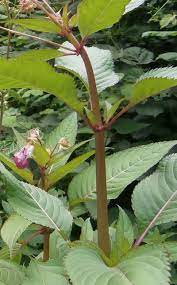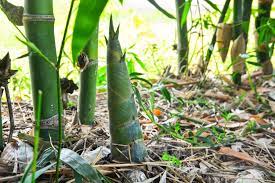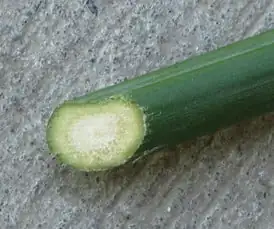Knotweed Quiz
Complete the Identification Parade below. For each plant characteristic, we show three images, one of which is knotweed.
Test yourself by simply clicking or tapping the image
It will confirm whether the plant you suspect is or is not knotweed and the accompanying text will explain why.
1. Stems in Summer



Correct! This photo is Japanese knotweed. The stems in summer have distinctive purple flecks and zig-zag shape.
This photo is bamboo. The stems are straighter and more wood like.
This plant is Himalayan Balsam. The stems have a similar colouring to Japanese knotweed but do not have the zig-zag shape and alternating leaf pattern.
2. Shoots



Yes! Japanese knotweed shoots look like asparagus when they first appear in spring and have the purple flecked colouring. There are distinct nodes from which leaves will grow out of as the shoot develops.
This photo is of peony shoots. The colour is similar; however, the leaf pattern and stems do not resemble Japanese knotweed. Japanese knotweed will grow more rapidly and significantly taller than peonies.
Close – but this photo is bindweed. It is often mistaken for Japanese knotweed because of its similar colouring (and ability to grow everywhere!). The key difference is bindweed is not self-supporting and will grow around other plants, whereas Japanese knotweed will grow vertically on its own.
3. Buds



So close, but these are peony buds. They look extremely similar to Japanese Knotweed when they first appear. Once they develop into the shoots shown above it is much easier to distinguish the differences. At this stage of growth, look out for whether the old dead canes and crowns can be seen in the same area as the new buds – this is indicative of Japanese knotweed.
This was a hard one, and you are correct! These buds are Japanese knotweed. Bright red when they first appear, and they will grow very quickly into the shoots seen above.
This photo is bamboo. The buds have a conical shape and green colouring. Even though Japanese knotweed stems have the same green tone, the initial buds are bright red.
4. Winter Canes



Well done! These are the dead canes of Japanese knotweed. The canes grow from a crown in the ground, and the distinctive zig-zag shape will be visible. The best way to distinguish Japanese knotweed canes from others in winter is to crack one open and see if it is hollow inside. If it is, it’s probably knotweed.
This photo is broadleaf dock. A great Japanese knotweed look-alike! The best indicator is the large green leaves at the base of the plant which are not a feature of Japanese knotweed.
So close – bramble looks like Japanese knotweed in winter, however the stems are not hollow.
5. Flowers



So close! The colour is similar, but these are the flowers of Russian vine. They look the same from a distance but watch out for the vinelike stems that will be wrapped around other plants. Japanese knotweed stems are self-supporting.
The common culprit of misidentification, bindweed, also has white flowers in summer. As you can see, they are larger and more separated than the bunched blooms of Japanese knotweed.
Yes – these are Japanese knotweed flowers in the summer months. These delicate white flowers are visible along the distinctive zig-zag stems.
6. Leaf Tip



Correct! This is the distinctive drip-tip of a Japanese knotweed leaf. It is specifically designed to allow water to fall off the end.
Not quite! This is magnolia leaf and has crinkled edges, unlike the Japanese knotweed which is straight edged.
Not quite! This photo shows a leaf with multiple pointed tips, not the singular drip-tip of the Japanese knotweed leaf.
7. Leaf Edge



Yes – this is Japanese knotweed! You can see the pointed tip and the leaf also has a smooth edge.
Unfortunately, this photo is a nipplewort leaf and does not have the smooth edges of Japanese knotweed.
Unfortunately, this photo is a dock leaf and does not have the smooth edges of Japanese knotweed.
8. Inside Stem



You’re right! Break open the stem of Japanese knotweed and it will always be hollow on the inside, whatever the time of year. This identifying feature is especially helpful in the winter months when identifying Japanese knotweed can be more difficult.
This is bramble. As stated above, it looks very similar in its dead cane form but break it open and you can see it is not hollow.
This is another example of a filled in stem – a solid culm. You can see why the hollow stem characteristic is so important to Japanese knotweed identification.
9. Leaf Pattern



Yes, this is Japanese knotweed. The distinctive zig-zag shape comes from its alternate leaf pattern (no two leaves will grow from the same node).
No, this is not Japanese knotweed. This photo shows a pinnate leaf type, where the leaves grow from the same node on either side.
No, this is not Japanese knotweed. This photo shows a whorled leaf arrangement, where more than two leaves grow from the same node in a circular pattern.
10. Leaf Base



Yes – Japanese knotweed has a flat based leaf, giving it a spade/heart shape.
This maple leaf has a crinkled base and is not Japanese knotweed.
This photo shows a rounded leaf base, very common among plants that could be misidentified as Japanese knotweed.
11. Self-Supporting Stem



This photo is bindweed. See how the stems are very thin and windy – this is because it needs other plants or structures to support it.
Well done! Japanese knotweed has self-supporting stems, meaning that the plant does not rely on other plants or structures to grow. As the shoots come out of the ground they will grow vertically and very quickly (up to 10cm per day).
Close, the colouring and leaves are similar, however, this is Russian vine. It needs to wrap itself around other plants or structures for support whereas Japanese knotweed can stand alone.
Start fixing your invasive plant problem today by requesting a survey
Request Survey
Rest assured, where invasive species are identified at an early stage and tackled correctly, problems can usually be avoided. Our trained specialists carry out site surveys to map specified terrestrial invasive plant species and provide management plans tailored to your requirements.
GET IN TOUCH
Contact Us
Our friendly team are ready to take your enquiry. Whether you’re unsure if you you have a problem with invasive plants, or are looking for
Want a survey?
Request a survey online in less than two minutes by simply uploading a photograph and providing a few brief details. A member of the team will swiftly come back to you with further information and our availability.
Not sure if you have knotweed?
There’s no need to wait for a survey. Simply upload an image to our identification form and one of our invasive plant experts will take a look and let you know, free of charge.



